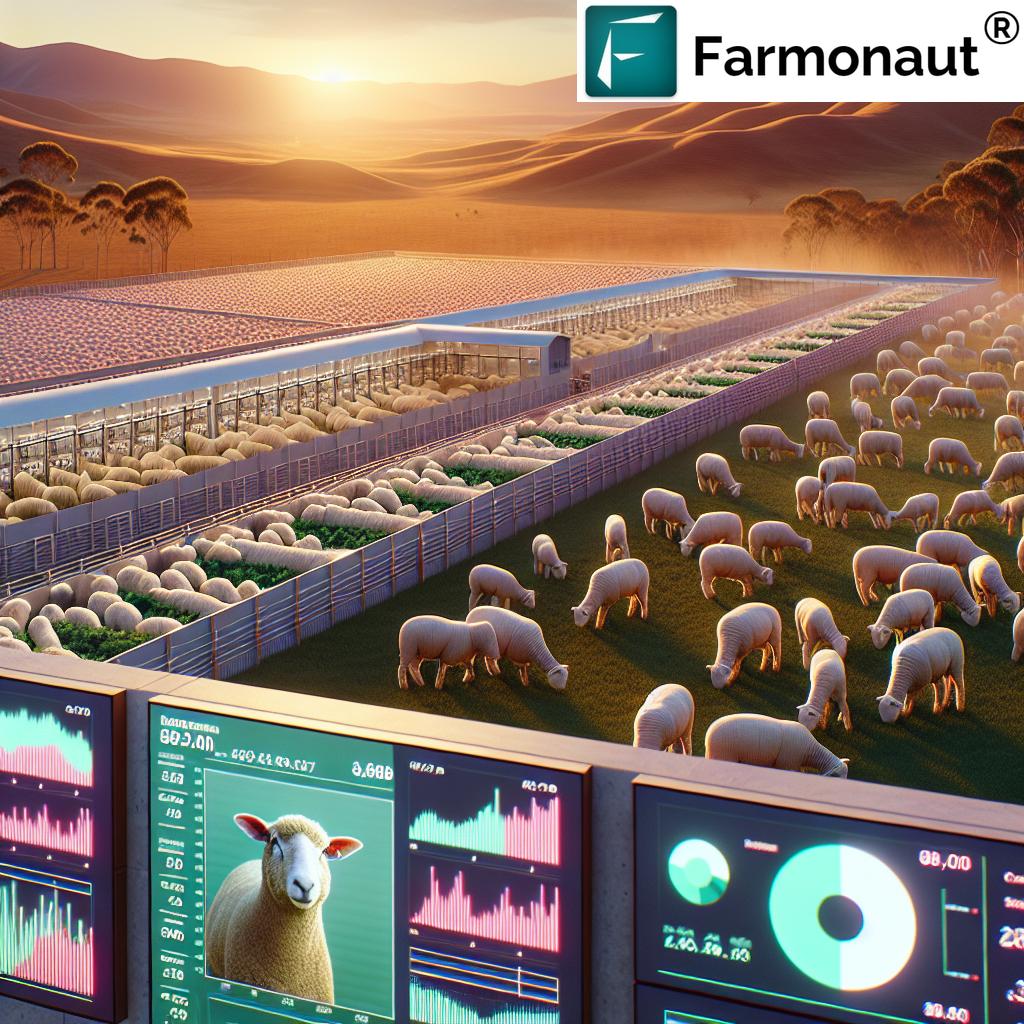Australian Wool Market Insights: Leveraging Precision Agriculture for Sustainable Production
“Australia’s wool industry exports over 270 million kilograms annually, contributing significantly to the global textile market.”
Welcome to our comprehensive analysis of the Australian wool market, where we delve deep into the heart of this vibrant and sustainable industry. In this blog post, we’ll explore the latest Australian wool market statistics, uncover emerging trends, and examine how precision agriculture is revolutionizing wool production. From wool production analysis to export trends, we’ll provide you with valuable insights that will help you navigate this dynamic sector.
As we embark on this journey through the Australian wool industry, we’ll cover a wide range of topics, including:
- Annual wool trading data and its implications
- Wool auction market insights and pricing trends
- The role of agricultural commodity reports in shaping the industry
- Wool classing standards and their importance in quality control
- How precision agriculture for wool is transforming production methods
- The latest agritech solutions for wool farmers
Whether you’re a wool producer, trader, or industry stakeholder, this blog will equip you with essential information to thrive in the Australian wool market. Let’s dive in and unlock the full potential of your wool farming enterprise!
The Australian Wool Market: An Overview
The Australian wool industry has long been a cornerstone of the country’s agricultural sector, renowned for producing some of the finest quality wool in the world. To better understand the current state of the market, let’s take a look at some key statistics and trends:
| Year | Wool Production (million kg) | Average Wool Price (AUD/kg) | Export Volume (million kg) | Sustainability Index (0-100) |
|---|---|---|---|---|
| 2019 | 300 | 18.50 | 278 | 75 |
| 2020 | 285 | 15.80 | 265 | 78 |
| 2021 | 290 | 13.50 | 270 | 82 |
| 2022 | 295 | 14.30 | 273 | 85 |
| 2023 | 305 | 16.20 | 280 | 88 |
As we can see from the table above, the Australian wool market has experienced some fluctuations in recent years. While production volumes have remained relatively stable, average wool prices have seen some volatility. However, it’s encouraging to note that export volumes have been steadily increasing, and the industry’s commitment to sustainability is evident in the rising Sustainability Index scores.
Wool Production Analysis: Trends and Challenges
Understanding the intricacies of wool production is crucial for anyone involved in the industry. Let’s break down some key aspects of wool production analysis:
- Regional production variations: Different areas of Australia contribute varying amounts to the national wool clip. Factors such as climate, soil quality, and farm management practices influence these regional differences.
- Seasonal fluctuations: Wool production is inherently seasonal, with shearing typically occurring once or twice a year. This seasonality can impact market supply and prices.
- Flock composition: The age and breed of sheep in a flock significantly affect wool quality and quantity. Merino sheep, known for their fine wool, dominate the Australian wool industry.
- Environmental challenges: Drought, bushfires, and other environmental factors can have substantial impacts on wool production, affecting both quantity and quality.
To address these challenges and optimize production, many Australian wool farmers are turning to innovative solutions. This is where Farmonaut’s precision agriculture tools come into play.

Leveraging Precision Agriculture for Wool Production
Precision agriculture is revolutionizing the wool industry, offering farmers powerful tools to optimize their operations. Farmonaut, a leading agricultural technology company, provides cutting-edge solutions that can significantly benefit wool producers:
- Satellite-Based Crop Health Monitoring: While wool production doesn’t involve crops in the traditional sense, pasture health is crucial for sheep grazing. Farmonaut’s satellite imagery can help farmers monitor vegetation health (NDVI) and soil moisture levels, ensuring optimal grazing conditions for their flocks.
- Jeevn AI Advisory System: This AI-driven tool delivers real-time insights and expert management strategies tailored to wool farming. It can help predict optimal shearing times, manage flock health, and optimize grazing rotations.
- Resource Management: Efficient management of water and other resources is crucial in wool production. Farmonaut’s tools can help farmers optimize resource allocation, reducing waste and improving sustainability.
By integrating these agritech solutions for wool farmers, producers can make data-driven decisions that lead to improved wool quality, increased yield, and more sustainable farming practices.
Annual Wool Trading Data: Market Insights
Understanding annual wool trading data is essential for both producers and traders in the Australian wool market. Let’s examine some key aspects of this data:
- Trading volumes: The total amount of wool traded annually provides insights into market demand and supply dynamics.
- Price trends: Analyzing year-on-year price changes helps in understanding market conditions and forecasting future trends.
- Buyer demographics: Information on major buyers, both domestic and international, can inform marketing strategies and export plans.
- Seasonal patterns: Identifying recurring patterns in trading data can help stakeholders make informed decisions about when to buy or sell.
Farmonaut’s data analytics capabilities can be particularly useful in interpreting this trading data. By leveraging AI and machine learning algorithms, farmers and traders can gain deeper insights into market trends and make more informed decisions.
Wool Export Trends: Global Market Dynamics
“The Australian wool market conducts over 80 auctions per year, processing millions of bales for domestic and international trade.”
Australia’s wool exports play a significant role in the global textile industry. Let’s explore some key wool export trends:
- Major export destinations: China remains the largest importer of Australian wool, followed by Italy, India, and South Korea.
- Changing demand patterns: There’s a growing demand for sustainably produced wool, driven by increasing consumer awareness of environmental issues.
- Value-added exports: There’s a trend towards exporting more processed wool products rather than just raw wool, adding value to exports.
- Impact of trade agreements: Free trade agreements with various countries have opened up new markets and opportunities for Australian wool exports.
To capitalize on these trends, wool producers can leverage Farmonaut’s blockchain-based traceability solutions. This technology allows producers to showcase the sustainability and quality of their wool, potentially opening up premium markets and improving export prospects.
Sustainable Wool Industry: Balancing Production and Environment
The sustainable wool industry is not just a buzzword; it’s becoming a necessity in today’s environmentally conscious market. Here’s how the Australian wool industry is embracing sustainability:
- Regenerative farming practices: Many farmers are adopting methods that improve soil health and biodiversity on their properties.
- Animal welfare: There’s an increasing focus on ethical sheep farming practices, including alternatives to mulesing.
- Carbon footprint reduction: The industry is working towards reducing its carbon emissions through various initiatives.
- Water conservation: Given Australia’s often drought-prone climate, efficient water use is a key focus for sustainable wool production.
Farmonaut’s precision agriculture tools can play a crucial role in promoting sustainability in wool farming. For instance, the platform’s carbon footprinting feature allows farmers to monitor and reduce their environmental impact in real-time.

Wool Auction Market Insights: Understanding the Sales Process
The wool auction system is a crucial component of the Australian wool market. Let’s delve into some wool auction market insights:
- Auction frequency: Wool auctions are typically held weekly in major selling centers across Australia.
- Price determination: Prices are set through an open-cry auction system, where buyers bid on lots of wool.
- Quality factors: Wool is graded based on various factors including fiber diameter, strength, and yield, which influence its price.
- Market indicators: The Eastern Market Indicator (EMI) is the key benchmark used to track overall wool market performance.
Farmonaut’s real-time data analytics can provide valuable insights for both buyers and sellers in the auction market. By analyzing historical data and current market conditions, stakeholders can make more informed decisions about when to buy or sell wool.
Explore Farmonaut’s API for real-time market data
Agricultural Commodity Reports: Informing Industry Decisions
Agricultural commodity reports play a vital role in shaping the wool industry. These reports provide valuable information on:
- Production forecasts: Estimates of future wool production help stakeholders plan for upcoming seasons.
- Price projections: Analysts use various factors to predict future wool prices, aiding in financial planning.
- Global market conditions: Understanding international trends is crucial for an export-oriented industry like wool.
- Policy impacts: Reports often analyze how government policies might affect the wool industry.
Farmonaut’s data-driven approach complements these reports by providing real-time, farm-level data that can be aggregated to provide a more accurate picture of the industry. This combination of macro-level reports and micro-level data can lead to more informed decision-making across the sector.
Wool Classing Standards: Ensuring Quality and Consistency
Wool classing standards are essential for maintaining the quality and consistency of Australian wool. Let’s examine some key aspects:
- Classification criteria: Wool is classed based on factors such as fiber diameter, staple strength, and color.
- Training and certification: Professional wool classers undergo rigorous training and certification to ensure they can accurately grade wool.
- Technology in classing: Advanced tools are increasingly being used to assist in the accurate classification of wool.
- Impact on pricing: Proper classing ensures that wool receives fair market value based on its quality.
While Farmonaut doesn’t directly involve itself in wool classing, its precision agriculture tools can help farmers produce higher quality wool. By optimizing grazing patterns and flock health, farmers can improve the overall quality of their wool clip, potentially leading to better classifications and higher prices.
Check out Farmonaut’s API Developer Docs for integration possibilities
Precision Agriculture for Wool: Transforming Traditional Practices
Precision agriculture for wool is revolutionizing the industry. Here’s how:
- Pasture management: Satellite imagery and AI algorithms can help optimize grazing patterns and pasture rotation.
- Flock monitoring: Advanced sensors and IoT devices can track sheep health and behavior in real-time.
- Weather forecasting: Accurate, localized weather predictions help farmers make timely decisions about shearing and other activities.
- Resource allocation: Precision tools help in efficient distribution of water, feed, and other resources.
Farmonaut’s suite of precision agriculture tools is particularly well-suited for wool farmers. From satellite-based crop health monitoring to AI-driven advisory systems, these technologies can significantly enhance wool production efficiency and sustainability.
Agritech Solutions for Wool Farmers: Embracing Innovation
The adoption of agritech solutions for wool farmers is growing rapidly. Here are some key innovations:
- Drone technology: Drones are being used for aerial surveying of pastures and monitoring flock movements.
- Precision shearing tools: Advanced shearing equipment is improving efficiency and reducing stress on animals.
- Data analytics platforms: Software solutions are helping farmers make sense of the vast amount of data generated on modern farms.
- Blockchain for traceability: This technology is enhancing supply chain transparency and product authenticity.
Farmonaut’s platform integrates many of these technologies, offering wool farmers a comprehensive solution for managing their operations. By leveraging these agritech solutions, farmers can improve productivity, reduce costs, and enhance the sustainability of their wool production.
The Future of Australian Wool: Trends and Predictions
As we look to the future of the Australian wool industry, several trends and predictions emerge:
- Increasing demand for sustainable wool: Consumers are becoming more environmentally conscious, driving demand for sustainably produced wool.
- Technological integration: The adoption of precision agriculture and other agritech solutions is expected to accelerate.
- Diversification of export markets: While China remains the largest importer, there’s a push to diversify export destinations to reduce market dependence.
- Value-added processing: There’s likely to be a greater focus on processing wool domestically to add value before export.
- Climate adaptation: With changing climate patterns, the industry will need to adapt its practices to ensure resilience.
Farmonaut’s continuous innovation in agricultural technology positions it well to support the wool industry in navigating these future trends. By providing farmers with cutting-edge tools and data-driven insights, Farmonaut can help the Australian wool industry maintain its global leadership position.
Conclusion: Embracing a Data-Driven, Sustainable Future
The Australian wool market is at an exciting juncture, balancing its rich heritage with innovative technologies and sustainable practices. As we’ve explored in this blog, from wool production analysis to precision agriculture for wool, the industry is embracing change to meet future challenges.
By leveraging annual wool trading data, understanding wool export trends, and adopting agritech solutions for wool farmers, the industry is positioning itself for long-term success. The focus on sustainability, quality through rigorous wool classing standards, and the insights provided by agricultural commodity reports all contribute to a robust and forward-thinking sector.
Farmonaut’s suite of precision agriculture tools offers wool farmers the opportunity to optimize their operations, reduce environmental impact, and increase profitability. As the industry continues to evolve, embracing these technological advancements will be key to maintaining Australia’s position as a global leader in wool production.
The future of Australian wool is bright, sustainable, and data-driven. By combining traditional knowledge with cutting-edge technology, the industry is well-equipped to meet the challenges and opportunities that lie ahead.
FAQ Section
Q1: What is the current state of the Australian wool market?
A1: The Australian wool market has shown resilience in recent years, with stable production volumes and increasing export trends. While prices have fluctuated, there’s a growing focus on sustainability and quality, which is positively impacting the industry.
Q2: How is precision agriculture benefiting wool farmers?
A2: Precision agriculture tools, such as those offered by Farmonaut, are helping wool farmers optimize pasture management, monitor flock health, and make data-driven decisions. This leads to improved wool quality, increased yields, and more sustainable farming practices.
Q3: What are the main export destinations for Australian wool?
A3: China remains the largest importer of Australian wool, followed by countries like Italy, India, and South Korea. However, there’s a growing trend towards diversifying export markets to reduce dependence on any single destination.
Q4: How is the wool industry addressing sustainability concerns?
A4: The Australian wool industry is embracing sustainability through various initiatives, including regenerative farming practices, improved animal welfare standards, and efforts to reduce carbon emissions. Technologies like Farmonaut’s carbon footprinting tool are helping farmers monitor and reduce their environmental impact.
Q5: What role do wool classing standards play in the industry?
A5: Wool classing standards are crucial for maintaining the quality and consistency of Australian wool. They ensure that wool is accurately graded based on factors like fiber diameter and strength, which directly impacts its market value and helps maintain Australia’s reputation for high-quality wool.






